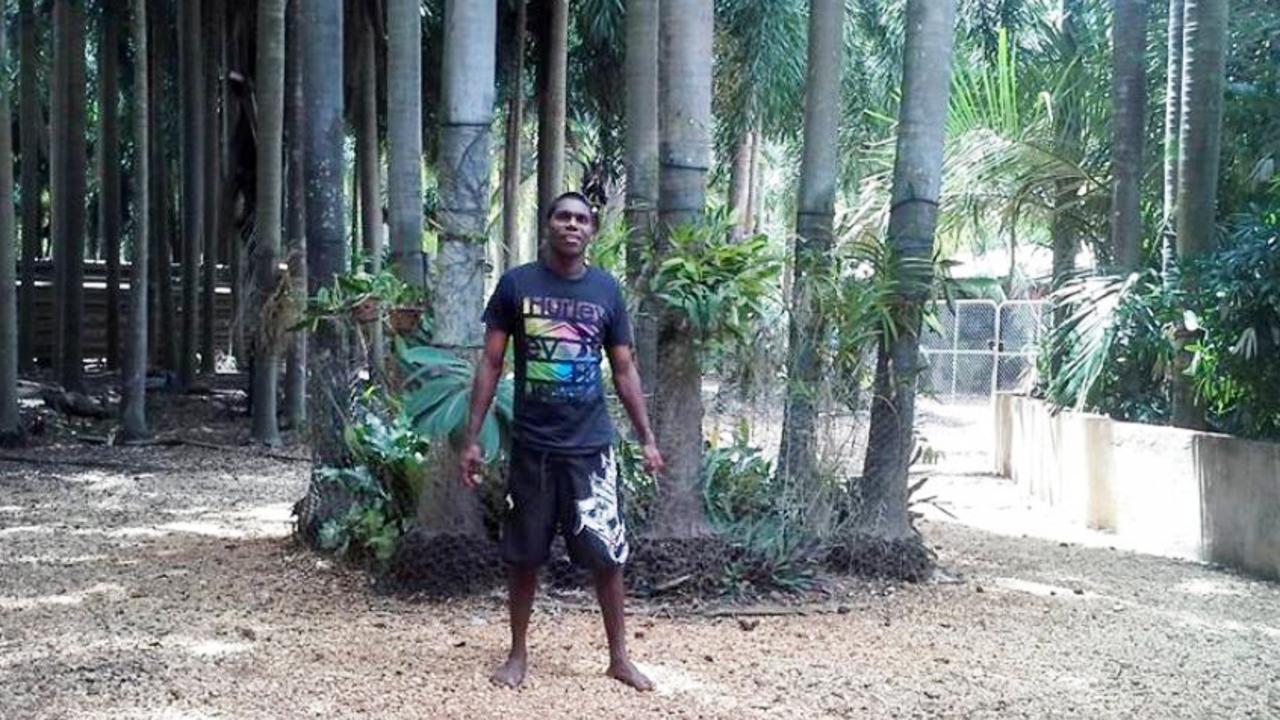Even among the worst monsters inside Holtze Prison, Rodney Kenyon is a special kind of crazy.
Kenyon, a convicted murderer and rapist, pottered away on gardening duty earlier this month while his latest Supreme Court trial played out, bizarrely, with neither a defendant nor a defence lawyer.
The notorious crim, who had sacked a string of lawyers before being cut loose by legal aid, had declared he was “sick of this sh*t” and didn’t want to take part in his own trial.
“I wanna go back to my cell, back to my block,” he said.
His agitated courtroom antics were odd — but not unexpected.
Granted his wish to leave the trial, Kenyon said, “all right, see you”, before wandering out of the prison’s videolink room.
After this, guards had him change out of his longsleeved shirt he wears on court days, and into one of the red, maximum security prison-issue T-shirts he will likely be wearing for much of the next 25 years.
Kenyon’s criminal history reads like the stuff of nightmares: a machete-armed double rape, a string of aggravated assaults, a shotgun-armed kidnapping, an ambush stabbing of a mate and, most-notoriously, the execution-style murder of Fabian Brock.
A string of judges and psychiatrists have struggled for words to describe Kenyon.
To one judge, he was a “bully and a coward”, to another he was a little more than a violent meth addict, to a third, he was “an extremely dangerous individual”.
One of the psychiatrists who have been asked to assess him described him as a man of “less than scintillating intelligence” but not intellectually disabled. Another said he was of “normal intelligence” albeit deeply troubled.
Others, who spoke to the NT News on the condition of anonymity, have described him as “a very complex fellow” and “a total nutjob”.
It was only in this latest — and likely last — Supreme Court trial where Kenyon himself stumbled on the word that best describes him.
In a recorded interview with Sergeant Matt Akers, the cop who arrested him after Fabian Brock’s execution on June 13, 2015, Kenyon begged not to be sent back to jail.
“I don’t want to go back in there, because it’s going to turn me into a monster again,” he said.
In an interview at Holtze Prison with renowned forensic psychiatrist Dr Lester Walton six months later, Kenyon said that it was behind bars where he was first introduced to meth — the drug that fuelled most of his horrendous crimes.
“He does not smoke this drug but he injects himself,” Dr Walton’s report, obtained by the NT News, says.
“Typical use when at large was around one gram daily.
“Mr Kenyon denied that he was especially prone to paranoia or aggression when using such a stimulant drug.”

Kenyon’s denial of anger, aggression and paranoia would come as a surprise to virtually anyone who has ever seen Kenyon in full flight, either on the streets, behind bars, or in a courtroom.
Police records show Kenyon as being erratic and aggressive, with officers struggling to wrestle him into the back of a paddywagon.
“(He) remained highly aggressive and was screaming abuse from the rear of the cage at police members,” a police report said.
Dr Walton, who has interviewed virtually every “lifer” in Holtze Prison, hundreds of the country’s most puzzling rapists and murderers, said of Kenyon: “(He) has a worrisome accumulating criminal history.
“He comes from a family where anti-social behaviour seems to be the norm and it is probable that he carries a genetic loading in that direction.”
The violence and paranoia that were part and parcel with Kenyon’s killing seem to have continued, at least for a while, inside jail.
“Mr Kenyon runs into recurring conflict with fellow prisoners and thus his situation in prison is more onerous than many because he is placed in protection,” Dr Walton said.
“In relation to those matters where Mr Kenyon does acknowledge his wrongdoing, his expression or remorse is striking by its absence.”
Six months later, in 2016, another renowned forensic psychiatrist, Dr Olav Nielssen, dialled in to Holtze Prison with a similar brief — to try and figure out what made Kenyon tick.
A month after being sentenced on rape charges — for which he was ultimately jailed for 11 years and six months, Kenyon told Dr Nielssen he had always been slightly unhinged.
“I am a bit loose ... I am a wild one ... I am out there ... I grew up rough and that is the way I live ... you can’t press rewind and change,” he said.
Kenyon said he would inject “half a gram ... maybe a gram of good quality methamphetamine every day” and denied his fear people were poisoning him with rat-sac or battery acid was a delusion.
“This is reality,” he said. “It’s not a conspiracy ... it’s happening every day.
“It was probably my enemies ... of course there was people after me ... I have caused people warring on ... people want to kill me saying I am being two-faced.”
More than a year after he had been arrested following his brutal crime spree, Kenyon opened up about his sorry past.
“There was no love in my life ... I thought I would go out on the streets and live my own life ... I raised myself up,” he said.

He turned to drinking by age eight and sniffed petrol briefly, but found refuge on the basketball court and footy field until he was first locked up.
“I love drinking ... I drink with a passion,” he said.
Dr Nielssen, like most people, couldn’t get to the bottom of why Kenyon thought people were poisoning him, and simply described it as a “bizarre belief”.
The doctor concluded Kenyon, after nearly a decade of using meth, had a substance abuse disorder and probably became psychotic when he injected his drug of choice.
Nobody knows precisely what tipped Kenyon into going on a his brutal crime spree during his last days as a free man in 2015.
In less than three days he stabbed Linton Baird, threatened to kill Ashley Connolly, murdered Fabian Brock and kidnapped Jacob Noble-Webster at gunpoint.
He was also accused of shooting at Shane Mulhall and Raymond Petterson-Cummings, charges of which a jury acquitted him.
Justice Stephen Southwood said in March, Kenyon’s crimes had “the common features ... of weapons, threats to kill, use of violence and deprivation of liberty”.
In sentencing Kenyon to life behind bars for Mr Brock’s murder, Justice Southwood said: “He has still not informed the court, or anybody else so far as it can be ascertained, why he murdered Fabian Brock”.
The same is true for why he stabbed his friend, Linton Baird two days earlier, other than the bizarre paranoia he was being poisoned and the unlikely suggestion — rejected by a jury — that he was acting in self defence.
Like most of the Territory’s worst murderers, there is something elusive about Kenyon.
Something which even the psychiatrists paid to nut out the country’s most hardened criminals have been unable to fully explain.
Like fellow notorious killers Bradley Murdoch, Matej Vanco, Andy Albury, Ben McLean and Phu Ngoc Trinh, whatever is going in their heads stops mattering at some point.
Justice Peter Barr will in early December will begin hearing Kenyon’s final sentencing proceedings, which could see his 25-year non-parole period extended.
Everyone who spoke about Kenyon told the NT News was adamant the Parole Board should take the advice of Fabian Brock’s family and friends, who, as he was being taken away for sentencing after Mr Brock’s murder, said the 26-year-old should “rot in hell”.


NT policing changes planned to target anti-social behaviour in public places
Hot on the heels of plans to boost public safety with a pepper spray trial, the CLP is undertaking more policing reforms targeting anti-social behaviour in public places. Watch the Chief Minister’s interview.
WATCH: Porkers saving their bacon in Daly River croc attack
A NT News video of a drove of feral pigs trying to save their bacon swimming across a croc infested Northern Territory waterway has gone viral. WATCH THE VIDEO.